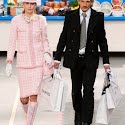By Bill O'Sullivan
03rd Jul 2014
03rd Jul 2014
Maybe the latest fashions are designed to put men off and explore our common bonds
Something strange is happening in fashion at the moment. In fact, most would call it something ugly. The flat-bottomed mom jeans, the ?embarrassing dad?-inspired sock and sandal combo, the granny-style Birkenstocks, the sickeningly girlish fluffy handbags and childish jelly sandals. All so desperately kitsch, and, as far as most people are concerned, downright ugly.
And it’s not just on the High Street or amongst the much speculated upon ?hipsters? of our generation. This taste for so-called Ugly has made its way onto the catwalk, led by none other than Muccia Prada. Her Spring/Summer collection featured an array of loose woollen dresses, painted with cartooinish bras and portraits of women’s faces in dark, unappealing colors for a summer wardrobe- mustard yellows, murky greens and donkey browns. All this teamed with furry cocoon coats and a high-end version of the socks & sandals look, with ankle-less knee high sports socks and strappy heels. So far, not exactly what we have come to expect on the usually glamorous high fashion catwalk.
Chanel, another historic trailblazer, was also on the bandwagon with Lagerfield’s avant-garde supermarket-themed A/W 14 collection, complete with trolleys, baskets and aisles of groceries. Whatever about the props, what was most surprising was the banality of the clothes, with classic Chanel tweeds re-structured into worn-looking casual tracksuits and branded runners followed by old-fashioned tweed two-pieces you’d expect your posh granny to wear. Added to this were Chanel bags packaged like butcher meats and shopping baskets entwined with the trademark Chanel chain links. The show took everyday looks you would see worn in your local supermarket and exaggerated their shapes and detailing, restructuring them with signature tweed and chain links into high-fashion ensembles. It all gave an uncanny impression of what was previously considered by the fashion world to be conventionally normal, unfashionable and, most importantly, ugly.
From the world’s best designers down to the cheapest of the High Street rails, the theme is recurrent. It’s official. What is unflattering, kitsch and overly familiar, hideous to us, even cringey, is now en vogue. Ugly is the new black. ill-fitting garments and clashing accessories are taking over fashion. But why ?Ugly? as the trend of the moment, and why now? ?And if these clothes are so unattractive and unappealing, do we care that they’re sure to repel any straight man?
One fashion blogger who foresaw, if not drove, this trend was Leandra Medine, creator of the now famous blog,?The Man Repeller.?Medine catalogues her outfit choices on the blog whose title she and a friend coined, but what exactly is a man repeller?
man’re?pell?er1? [mahn-ree-peller]
?noun
She who outfits herself in a sartorially offensive mode that may result in repelling members of the opposite sex. Such garments include but are not limited to harem pants, boyfriend jeans, overalls, shoulder pads, full length jumpsuits, jewelry that resembles violent weaponry and clogs.
Medine started the blog in 2010 to express her love of fashionable yet not necessarily flattering clothing. Surprising to some, her flair for the stylishly ugly soon catapulted her blog to fame, and it is now continuously voted as one of the top blogs in the fashion world with Medine one of the most influential fashion bloggers of the past four years. Described as ?a fashion blog dedicated to the celebration of trends that women love and men hate?, blog followers everywhere found something that resonated with them in Medine’s unapologetic love of artistic clothing and complete disregard for her sex appeal. She’s captured an audience of millions and her blog forecasted a major style trend that has evolved in the past four years, culminating in this summer’s trends.

Medine’s success is partly due to her timing. Her unapologetic celebration of Ugly captured an audience exhausted and bored with prevailing fashion trends and hungry for something new. For modern women, the demands of perfection and prettiness have pretty much gone as far as they can go. We dye our hair and our skin, we paint our faces and our nails, we sew and glue other women’s hair onto our scalps and eye-lids while tweezing, plucking, ripping and waxing hair from everywhere else. We wear ever more revealing and uncomfortable clothing, and bend our feet into tortuous stilettos to change our height. We put plastic silicone inside our breasts and have the fat from our bottoms removed and injected into our lips. Future generations will probably marvel at these norms as bizarre and obsessive; in many ways they are more gruesome than spine-bending corsets or tightly bound feet.
The constant pressure to look good and be beautiful is exhausting. In the pursuit of ‘sexual empowerment? we have become slaves to our own sex appeal. Not only is the constant drive to look sexy and beautiful tiring but women are getting bored with it, too. Dressing overtly sexily is not shocking any more in a society constantly bombarded with pornographic images. Instead, if you want to get people talking, really cause an outrage and face the barrage of social critique, then dressing Ugly is what will really drop peoples’ jaws. Apparently, given today’s pressure on women to strive for beauty and perfection, the most revolutionary thing a woman can do is deliberately appear unattractive.
What’s great about Ugly is that it refocuses fashion and beauty into its purest and most powerful form. While some call fashion superficial, like it or not, your appearance is the most public representation of yourself. Some cower at that idea, but fashion lovers find power in it. They play with it and subvert society’s expectations with it. To do so requires confidence and a strong sense of self; it’s in strident individuality, the rejection of society’s obsession with perfection and giving the middle finger to sexual objectification, that Ugly finds its beauty.

As Medine explains, ?”Man Repelling isn’t about getting dressed and saying ‘How am I going to repel a man today?’ It’s about dressing for yourself and liking what you’re wearing.? In rejecting the male gaze, it also causes us to refocus our vision onto each other as women and re-evaluate what we want fashion to mean to us. Prada’s collection literally has us come face to face with other women through garments which are printed with images of women’s faces (see Image’s June cover), emphasizing how fashion can be a medium?for women to express themselves and communicate with each other. Likewise, the Chanel supermarket collection demands we look to other women around us for our fashion inspiration, regardless of class, age or race. There is something inherently feminist in this collection, particularly in its catwalk presentation. The fact the models are there for food, a basic human need, emphasizes a common bond, celebrates it and asks us to see the beauty in the everyday.
Ugly ain’t a style that will invite wolfwhistles but perhaps more likely will leave a trail of confused faces, and there is a certain kind of amusing empowerment in that small act of bravery. So throw on your mom jeans, your cheerleader socks and chunkiest nun sandals and embrace it. Perhaps, then we can all rediscover our real beauty again.
Rachel Lavin @RachelLavin
Chanel’s Supermarket Sweep: S/S14 Collection







































